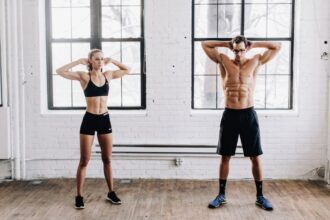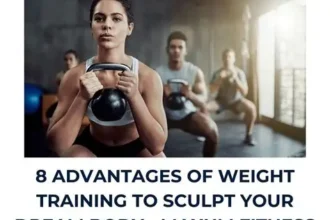focus keyword:Weighted Vests
Welcome to iHoxi, your trusted source for fitness gear and expert advice.
Introduction
Weighted vests have become essential tools for athletes and fitness enthusiasts looking to boost strength, endurance, and calorie burn. We consulted with some of New York City’s top personal trainers and fitness experts to bring you the 6 best weighted vests that can elevate your workouts and help you reach your fitness goals faster.
Why Use a Weighted Vest?
Weighted vests add extra resistance to your bodyweight exercises, cardio routines, and functional training. According to fitness expert ACE Fitness, wearing a weighted vest increases workout intensity, improves muscle strength, and enhances cardiovascular endurance. NYC trainers recommend them for everything from running in Central Park to strength circuits at local gyms.

The 6 Best Weighted Vests Recommended by NYC Trainers
- Hyperwear Hyper Vest PRO – Known for its comfortable fit and adjustable weight plates, perfect for intense training sessions. Learn more.
- Cross101 Adjustable Weighted Vest – Affordable and versatile, ideal for beginners and intermediate users. View details.
- RUNmax Pro Weighted Vest – Offers a secure fit and durable construction, favored by NYC boot camps. Check it out.
- Rogue Plate Carrier Vest – Designed for tactical training, it combines weight capacity with rugged durability. See more.
- MiR Weighted Vest – A budget-friendly option with customizable weight and breathable fabric. Explore here.
- Tone Fitness Weighted Vest – Compact and lightweight, great for high-intensity interval training (HIIT). Discover more.
Where to Train with Weighted Vests in New York City
NYC offers many excellent gyms and outdoor spots where trainers incorporate weighted vest workouts into their programs:
- Central Park Fitness Bootcamps – Great for outdoor training and cardio with weighted vests. Location: Central Park, New York, NY 10022.
- Rumble Boxing NYC – High-intensity classes often using weighted vests. Location: 415 W 13th St, New York, NY 10014.
- Equinox Midtown East – Full-service gym with trainers who specialize in weighted resistance training. Location: 645 3rd Ave, New York, NY 10017.
How to Choose the Right Weighted Vest for You
Selecting the right weighted vest depends on your fitness level, workout style, and budget. NYC trainers suggest considering factors like adjustable weight, comfort, breathability, and fit. If you’re new to weighted vests, start with lighter weights and gradually increase. For in-depth advice, check out our Weighted Vest Buying Guide on iHoxi.
Benefits of Using a Weighted Vest in Your Workouts
Weighted vests add extra resistance to your bodyweight exercises, making your muscles work harder and improving overall strength. This additional load helps increase calorie burn, enhances cardiovascular endurance, and can accelerate fat loss. Experts say wearing a weighted vest during exercises like push-ups, squats, or running can elevate your fitness level faster than traditional workouts.
How to Safely Incorporate Weighted Vests into Your Training
When starting with a weighted vest, it’s important to begin with lighter weights and gradually increase as your strength improves. Avoid adding too much weight too quickly to prevent injury. Always ensure the vest fits snugly and distributes weight evenly. Consult with a personal trainer or fitness coach, especially if you have any underlying health conditions or joint issues.
Top Features to Look for in a Weighted Vest
Choosing the right weighted vest can make a significant difference in your workout experience. Look for adjustable weights to customize resistance, breathable and moisture-wicking fabric for comfort, and a secure fit to prevent shifting during movement. Durability is also key—high-quality materials ensure your vest lasts through intense training sessions.
Where to Find Weighted Vest Workouts in New York City
If you’re in NYC, consider joining fitness classes that incorporate weighted vests. Places like Rumble Boxing NYC and outdoor bootcamps in Central Park offer dynamic training sessions with added resistance gear. These venues provide expert coaching to help you maximize results safely.
Maintaining Your Weighted Vest for Longevity
Proper care of your weighted vest ensures it remains effective and comfortable. Follow manufacturer cleaning instructions, usually involving spot cleaning and air drying. Store your vest in a dry place to prevent mold or material degradation. Regularly inspect the weights and straps for wear and tear to maintain safety during workouts.
Why Weighted Vests Are Popular Among Professional Trainers
Professional trainers in New York City recommend weighted vests because they provide a versatile way to intensify workouts without requiring additional equipment. Whether used in HIIT sessions, running drills, or strength training, weighted vests help clients break plateaus by challenging muscles in new ways. This popularity is reflected in many NYC gyms incorporating vests into their group classes and personal training programs.
Weighted Vests vs. Traditional Weights: Which Is Better?
While traditional weights like dumbbells target specific muscles, weighted vests distribute resistance across your torso, engaging multiple muscle groups simultaneously. This makes vests ideal for functional fitness and endurance. Experts suggest combining both for balanced strength development. However, weighted vests are especially effective for improving bodyweight exercises and cardiovascular workouts.
How Weighted Vests Improve Cardiovascular Health
Adding a weighted vest to your cardio routine increases the intensity by forcing your heart and lungs to work harder. Studies show that this additional resistance can improve VO2 max—the maximum amount of oxygen your body can use during exercise—leading to better stamina and heart health. NYC trainers often use weighted vests to elevate running and walking sessions, especially in outdoor settings like Prospect Park.
Customizing Your Weighted Vest Workout for Maximum Results
To get the most from your weighted vest, vary your exercises and gradually increase the weight. Combine cardio, strength training, and mobility drills for a well-rounded routine. NYC fitness experts recommend tracking progress and listening to your body to avoid overtraining. Remember, rest and recovery are just as important as the workout itself.
Where to Buy Quality Weighted Vests in New York City
For those looking to purchase a weighted vest locally, NYC offers several specialty fitness stores and sports shops. Retailers like Dick’s Sporting Goods and REI NYC carry a variety of options for all budgets. Trying on vests in-store can help ensure proper fit and comfort before investing.
FAQS
1. What is a weighted vest, and how does it work?
A weighted vest is a piece of fitness equipment designed to add extra resistance to your bodyweight exercises by distributing weighted plates or materials evenly across your torso. By wearing one, your muscles and cardiovascular system must work harder during workouts, which can improve strength, endurance, and calorie burn. The added load makes movements like running, squats, or push-ups more challenging, resulting in more effective training.
2. Who can benefit from using a weighted vest?
Anyone looking to increase the intensity of their workouts can benefit from a weighted vest, from beginners to elite athletes. Beginners should start with lighter weights to avoid injury, while advanced trainers use heavier vests to push their limits. Weighted vests are particularly useful for runners, HIIT practitioners, bodyweight trainers, and those aiming to enhance their functional fitness.
3. How much weight should I start with in a weighted vest?
It’s recommended to start with a vest that adds about 5-10% of your body weight. For example, if you weigh 150 pounds, starting with 7.5 to 15 pounds is ideal. Starting light helps your body adapt safely, reducing the risk of strain or injury. As you build strength and endurance, you can gradually increase the vest’s weight.
4. Are weighted vests safe to use?
Yes, weighted vests are generally safe when used correctly. Proper fit, starting with manageable weights, and avoiding sudden increases in load are crucial. Consulting a fitness professional is advised, especially if you have pre-existing conditions such as joint problems or cardiovascular concerns. Listening to your body and maintaining good form will minimize injury risks.
5. Can weighted vests help with weight loss?
Weighted vests increase the intensity of physical activity, which can boost calorie burn and metabolism. When combined with a healthy diet and consistent exercise, wearing a weighted vest can aid weight loss. The additional resistance requires your muscles to work harder, thus increasing overall energy expenditure.
6. How do weighted vests improve cardiovascular fitness?
Adding weight to your body during cardio activities forces your heart and lungs to work harder to supply oxygen, improving cardiovascular endurance. Over time, this increased effort can lead to improvements in VO2 max, which is a key indicator of cardiovascular health. Trainers often recommend weighted vests for running and walking to amplify these benefits.
7. Can I use a weighted vest for running?
Yes, weighted vests are excellent for runners wanting to increase intensity and strength. However, it’s important to start with lighter weights and shorter distances to avoid stress on joints. Incorporating weighted vest running sessions intermittently can improve speed, power, and endurance.
8. How do I ensure my weighted vest fits properly?
A proper fit is snug but not restrictive. The vest should distribute weight evenly without shifting during movement. Adjustable straps help secure the vest to your body, minimizing discomfort. Trying on different models, especially in stores, can help you find a vest that fits your torso shape and size comfortably.
9. What materials are weighted vests made from?
Weighted vests commonly use durable materials like nylon or neoprene for the vest itself, combined with removable weights made of steel or sand-filled pouches. High-quality fabrics offer breathability and moisture-wicking properties, which increase comfort during workouts.
10. Can weighted vests be used for strength training?
Absolutely. Weighted vests enhance bodyweight exercises such as push-ups, pull-ups, lunges, and squats by adding resistance. This increased load helps build muscle strength and endurance more efficiently compared to exercises without additional weight.
11. How often should I wear a weighted vest during workouts?
Frequency depends on your fitness goals and recovery ability. Many experts recommend 2-4 sessions per week initially, allowing rest days to prevent overuse injuries. As your body adapts, you can gradually increase frequency and duration based on your tolerance.
12. Are there any exercises that shouldn’t be done with a weighted vest?
Exercises that involve rapid, high-impact movements or heavy spinal loading, such as heavy squats or deadlifts, may not be suitable with a weighted vest. Also, people with back or joint problems should avoid using vests during high-impact activities. Always prioritize form and consult a trainer if unsure.

13. How do weighted vests compare to wearing ankle or wrist weights?
Weighted vests distribute load around the torso, engaging multiple muscle groups simultaneously and providing a balanced resistance. Ankle and wrist weights target smaller muscle groups and can sometimes alter natural movement patterns, potentially leading to injury. Vests are generally safer and more effective for whole-body training.
14. Can children use weighted vests?
Children should only use weighted vests under professional supervision and with very light weights appropriate for their size. The risk of injury from improper use or excessive weight is higher in children, so it’s important to prioritize safety and consult a pediatric fitness expert.
15. How do I clean and maintain a weighted vest?
Most weighted vests require spot cleaning with a damp cloth and mild detergent. Avoid machine washing as it can damage the weights or fabric. After use, allow the vest to air dry in a well-ventilated area. Regularly inspect straps and weights for wear and tear to ensure safety.
16. Can weighted vests help with bone density?
Weighted vests increase mechanical stress on bones during physical activity, which can stimulate bone growth and improve density. This is particularly beneficial for older adults or people at risk of osteoporosis, but any weighted vest use should be approved by a healthcare professional.
17. What is the difference between fixed-weight and adjustable weighted vests?
Fixed-weight vests have a set weight that cannot be changed, suitable for users who want simplicity. Adjustable vests allow you to add or remove weight plates or sandbags, offering versatility as you progress. Adjustable vests are generally recommended for their flexibility in training.
18. Are weighted vests suitable for all fitness levels?
Yes, weighted vests can be adapted for beginners, intermediate, and advanced users by adjusting the weight load and exercise complexity. Beginners should start light and focus on mastering form, while advanced users can challenge themselves with heavier weights and more intense workouts.
19. How much does a good weighted vest typically cost?
Prices vary widely depending on quality, materials, and weight capacity. Entry-level vests can cost around $50-$80, while premium models favored by trainers may range from $150 to $300 or more. Investing in a durable, comfortable vest is recommended for long-term use.
20. Can wearing a weighted vest improve posture?
Yes, the added weight encourages core engagement and muscle activation, which can help improve posture during exercise and daily activities. Consistent use strengthens stabilizing muscles, reducing slouching and promoting better spinal alignment.
21. Should I wear a weighted vest during bodyweight training or cardio?
Weighted vests are effective for both types of training. For bodyweight exercises, they add resistance to build strength, while during cardio like walking or running, they increase intensity and calorie burn. Combining both training styles with a vest leads to well-rounded fitness gains.
22. How long should a typical weighted vest workout last?
Workouts with a weighted vest can last anywhere from 15 minutes to an hour, depending on intensity and goals. Beginners might start with shorter sessions to allow the body to adapt, while experienced users can extend duration for endurance and strength training.
23. Can wearing a weighted vest help improve athletic performance?
Yes, many athletes use weighted vests to enhance speed, power, and endurance. The additional resistance improves muscle recruitment and cardiovascular capacity, which can translate to better performance in sports such as basketball, football, and track events.
24. Where can I buy quality weighted vests in New York City?
Quality weighted vests can be purchased at sporting goods stores such as <a href=”https://www.dickssportinggoods.com” target=”_blank” rel=”noopener”>Dick’s Sporting Goods</a>, specialty fitness stores, or online retailers like Amazon. Trying them out in stores like <a href=”https://www.rei.com/stores/new-york-city” target=”_blank” rel=”noopener”>REI NYC</a> ensures you get the right fit and comfort.

25. How do I incorporate weighted vests into my existing workout routine?
Begin by selecting exercises that complement your fitness goals and add the vest gradually. For example, add it to bodyweight squats or lunges on strength days, or wear it during walking or jogging on cardio days. Monitor your fatigue and recovery closely to avoid overtraining, and adjust the weight or duration as you progress.
Final Thoughts
Choosing the best weighted vests is essential for anyone looking to supercharge their workouts and achieve faster fitness results. The best weighted vests provide the perfect balance of comfort, adjustability, and durability to enhance strength and endurance training. When selecting from the best weighted vests, consider your fitness level and goals to find the vest that fits your needs perfectly.
Incorporating the best weighted vests into your routine can increase calorie burn, improve cardiovascular health, and boost muscle strength. Whether you are a beginner or an experienced athlete, the best weighted vests recommended by expert trainers in New York City will elevate your workout intensity safely and effectively. Invest in one of the best weighted vests today and experience the transformative benefits in your fitness journey.






